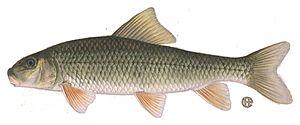Golden redhorse facts for kids
Quick facts for kids Golden redhorse |
|
|---|---|
 |
|
| Golden redhorse (Moxostoma erythrurum) | |
| Conservation status | |
| Scientific classification | |
| Synonyms | |
|
The golden redhorse (Moxostoma erythrurum) is a type of freshwater fish. It lives in Canada (Ontario and Manitoba) and many parts of the United States. You can find it in calm waters like streams, small to large rivers, and lakes.
This fish eats from the bottom of the water. Its diet includes tiny water creatures, insects, algae, and small mollusks. The golden redhorse lays its eggs in the spring.
Contents
Where Golden Redhorse Live
The golden redhorse lives in freshwater places across 25 different states in the eastern half of North America. You can find them in the big drainage basins of the Mississippi River, Ohio River, and the lower Missouri River.
These fish also live in most of the Great Lakes, except for Lake Superior. They are found in the Lake of the Woods too. You can also spot them in the Mobile Bay area in Alabama, Georgia, and southeastern Tennessee.
In Mississippi, there is a small group of golden redhorse in the southwestern part of the state. Scientists think they might be leftovers from a time when the fish lived in more places. People also brought them to the Potomac River in Maryland, Virginia, and West Virginia.
In Canada, the golden redhorse lives in Manitoba and Ontario. They are found in the Red River of the North, which flows into Hudson Bay. Interestingly, the Red River in Texas also has golden redhorse.
What Golden Redhorse Look Like
Golden redhorse fish are usually about 12 to 18 inches (30 to 46 cm) long. They weigh between 1 to 2 pounds (0.45 to 0.9 kg). Some can grow much bigger, up to 26 inches (66 cm) and weigh 4 to 5 pounds (1.8 to 2.3 kg).
Their name comes from the golden scales on their sides. Their backs are olive green, and their bellies are white. Their tail fins are slate gray. They have a streamlined body shape. This helps them swim against currents in streams to catch food.
The fish's mouth is on the underside of its head. Its back fin is a bit curved inward, and its tail fin has a notch. It has one anal fin and two pairs of fins: pelvic and pectoral fins. The pelvic fins are near its belly, while the pectoral fins are closer to its chest.
The golden redhorse has a special line of 39 to 42 scales along its side. This is called a lateral line system. It helps the fish feel movements and vibrations in the water around it.
Golden Redhorse Habitat
Golden redhorse fish live in freshwater streams, creeks, and rivers. These places have different types of bottoms, like gravel, sand, or silt. In deeper pools, they are often found over sand and silt.
Sometimes, they live in lakes or larger reservoirs that are connected to a stream or river. Compared to other redhorse species, the golden redhorse is quite tough. It can handle water that isn't perfect better than some other fish.
What Golden Redhorse Eat
The golden redhorse eats many different small water creatures. They munch on tiny insect larvae, small mollusks, and other small water bugs. Like most fish in the sucker family, they also eat detritus (dead bits of plants and animals) and algae.
The golden redhorse is a bottom-feeder. This means it finds its food on the stream bed. It has a special mouth that can stick out. This helps it suck up food objects from the bottom.
Reproduction and Life Cycle
Golden redhorse can live for at least 17 years. They become old enough to have babies when they are 3 to 5 years old. They lay their eggs in the spring. This happens when the water temperature is between 63-72°F (17-22°C).
The exact time depends on where they live, but spawning usually happens at night during April or May. They often lay eggs in fast-moving parts of the main stream, called runs or riffles. Some fish might move into smaller, safer streams to spawn.
The streams where they lay eggs usually have gravel bottoms. Their young, which live on the bottom, like to hide under the stones after hatching from their sticky eggs. Golden redhorse parents do not take care of their young.
The young fish often swim together in large groups. They feed together along the stream bottom. Sometimes, these groups might even include different types of redhorse fish.
Golden Redhorse and Humans
The golden redhorse is a popular fish for people who like to fish with a rod and line. Many anglers enjoy trying to catch them. People often catch golden redhorse by accident when they are fishing for catfish on the bottom.
Fishing for sucker fish, like the golden redhorse, often happens in early spring. This is when the water temperature reaches about 42°F (5.5°C). A good way to catch them is to fish a few inches off the stream bottom using simple worms as bait.
Another common way to catch suckers is called gigging. This involves using a multi-headed spear at night. Often, a light is mounted on the front of a boat to help see the fish.
Golden redhorse can be cooked in different ways. They can be cooked fresh, smoked, or even pickled. The world record for this species was a fish weighing 4 pounds, 1 ounce (1.84 kg). It was caught in French Creek in Franklin, Pennsylvania in 1997.


